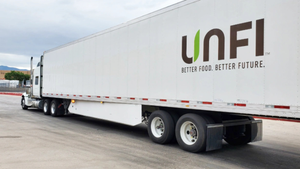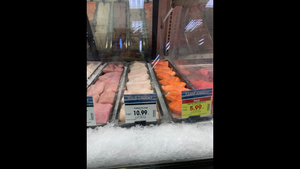Analysts See Reasons for Optimism for Supermarkets
“The thinking seems to be that things are not as bad as they were, though I doubt we will see any great increases in volumes.” — Meredith Adler, managing director, Barclays Capital Markets
May 6, 2013
Financial results for the first half of 2013 may be a little better than they were in the second half of 2012, industry analysts told SN.
“The thinking seems to be that things are not as bad as they were, though I doubt we will see any great increases in volumes,” Meredith Adler, managing director for Barclays Capital Markets, New York, said.
“January and February were tough for most retailers in general because consumers were dealing with higher payroll taxes, late refund checks, higher gas prices and a bad flu season.
“But I think the second quarter of this year will look a lot better because all those negative factors won’t be present and most people will have made whatever adjustments they need to make — though none of the improvements is really visible so far, and it’s not yet clear what is driving results.”

Click on image for larger version
Andrew Wolf, managing director for BB&T Capital Markets, Richmond, Va., said he expects this year’s first-half results to be better than last year’s second-half results “because conditions began improving after the holidays, and the economy has gotten a little better, which is good news for retailers — though inflation is still below the 2% to 3% levels they would like to see.
“The big news in the first half is that Kroger said it would no longer increase its price investments at an accelerated level — and when the market-share leader says it no longer needs to be quite as aggressive on pricing, that helps the whole industry.”
Wolf also said the sale of the big retail chains by Minneapolis-based Supervalu was “good news for the industry, and the likely shutdown of Fresh & Easy will be helpful to the sub-strata of operators.”
Bryan Hunt, managing director for Wells Fargo Securities, Charlotte, said he expects the weather to help first-half results outshine last year’s second half.
“The year has gotten off to a strong start,” he said, as cooler weather has kept people home, boosting supermarket sales, compared to last year’s warmer weather, which resulted in a significant expansion in food consumption away-from-home.
In addition, while competitive activity remains intense, the industry has adjusted to Wal-Mart Stores’ aggressive programs, which is helping to boost tonnage, “and the inflationary environment has been easier to manage,” he said.
Chuck Cerankosky, managing director for Northcoast Research, Cleveland, said he anticipates the first half will be pretty similar to last year’s second half. The problem, he said, is the lack of job growth, “which continues to be astonishingly slow, which affects consumer confidence, which impacts discretionary spending.
“Inflation slowed during the second half of last year, which should have encouraged shoppers to take advantage of better prices by buying more and trading up. But a large percentage of consumers remained reluctant because of still-uncomfortable levels of household debt and the poor jobs market.
“Though unemployment rates are down, the employment numbers remain lousy for a recovering economy. When jobs are growing, people are more confident about finding jobs if they need to so they feel more positive about their incomes improving.”
During the second half of 2012, sales for the 10 largest companies with public equity or debt rose 2.5% — relatively flat with the 3.5% in the first half of last year when inflation is factored out, analysts said.
Comparable-store sales rose an average of 0.7% during the third quarter of the calendar year and an average of 0.97% during the fourth calendar quarter, compared with increases of 3.6% and 2.9%, respectively, in the same periods a year ago.
When Whole Foods Market’s industry-leading comps are excluded from the comparison, results were again relatively flat, with third-quarter comps dropping an average of 0.1% and fourth-quarter comps rising an average of 0.3%.
Operating income for the second half fell to minus 0.4%.
Besides lower inflation, analysts attributed the poor second-half performance to a variety of factors.
“There were a lot of things spooking consumers and weighing on their shopping psychology, including all the negative commentary before the election, plus Hurricane Sandy and the murders in Newtown, Conn.,” Adler said.
Financial Performance for 10 Chains
Looking at each chain’s results individually, the analysts’ comments included the following:
• KROGER CO., Cincinnati, which saw sales for the second half rise 9.4% to $46 million, same-store sales go up 3.2% in the third quarter and 3% in the fourth, and operating income increase 18.1% to $1.1 billion — including the benefits of an extra week in the fourth quarter, pension adjustments and the Visa/MasterCard settlement.
Wolf said Kroger benefited from better margin performance in the fourth quarter, even without the extra week, because of better expense controls resulting from strong sales productivity.
“Kroger’s strategy is to drive so much sales growth that, even if margins are down, operating expense rates fall even more, which makes it very profitable because expenses don’t vary much, and the fourth quarter saw the culmination of that strategy,” he explained.
According to Adler, “Kroger’s strategy and execution continue to pay off, either because the competitive environment has been rational or because the company is so disciplined, and it hasn’t had any bad quarters for two years.”
• SAFEWAY, Pleasanton, Calif., whose sales increased 0.7% to $23.8 billion in the half, with same-store sales up 0.1% in the third quarter and 0.8% in the fourth and operating income rising 4.5% to $667 million, including gains from the sale of Genuardi’s and from the credit card settlement, plus an extra week in the fourth quarter.
Safeway’s results were largely driven by the expansion of Just for U.
“After a lot of work and an expanded launch, it appears Just for U is beginning to contribute to the top line, particularly as more CPG companies have signed on and put programs together that are in line with what Safeway is trying to do,” Cerankosky said.
Adler said she believes it’s still too early to determine how well Just for U is working. “It will take at least a year in each market to make that determination,” she explained.
• AHOLD USA, Quincy, Mass., which saw sales increase 2.6% to $12 billion in the half, same-store sales drop 1.5% in the third quarter and rise 1.4% in the fourth, and operating income increase 1.7% to $488 million.
Patrick Roquas, an analyst with Amsterdam-based Rabobank, said Ahold’s second-half results remained resilient, “driven by price investments and promotions, which were largely funded by ongoing cost savings.”
• SUPERVALU (retail only), Minneapolis, whose sales fell 7.4% to $10.2 billion, same-store sales dropped 4.3% in the company’s second fiscal quarter and 4.5% in its third, and operating income was off 6.4% to $12.1 million.
Supervalu became a different company a few weeks after the third quarter ended when it sold its largest retail assets (Albertsons, Acme, Jewel-Osco and the Shaw’s/Star Markets operation) to become a more wholesale-focused company.
“While Kroger has taken care of customers during the economic rough spots, Supervalu didn’t seem to do that at all, and the price perception of its retail chains kept deteriorating while the company made very little progress in rectifying that perception,” Cerankosky said.
• DELHAIZE AMERICA, Salisbury, N.C., whose second-half sales fell 2.3% to $9.5 billion, while same-store sales fell 1.6% in the third quarter and 0.8% in the fourth, and operating income declined 23.8% to $375 million for the half.
According to Roquas, margins at Delhaize America were heavily impacted during the half by price investments and the repositioning of Food Lion, “though volume trends improved gradually during the course of the second half.”
• WHOLE FOODS MARKET, Austin, Texas, which saw sales rise 19.5% to $6.9 billion, including an extra week in the fourth quarter, while same-store sales climbed 8.3% in the company’s fourth quarter and jumped 7.1% in its first quarter, and operating income was up 33.6% to $410.6 million.
Gross margins, more so than sales, were Whole Foods’ primary concern during the half, Wolf said. “Although sales remained very strong, earnings in the company’s first quarter came in below estimates because of pressure on gross margins.”
According to Cerankosky, “Whole Foods is an example of a chain that has been the epitome of making its name into the brand. People shop at Whole Foods because of what it stands for.
“The company has also found it can downsize its stores and provide a little bit more of a value message in its merchandising while maintaining same-store sales that are amazingly strong.”
• HARRIS TEETER, Charlotte, whose sales rose 3.7% to $2.3 billion, same-store sales rose 3% in the company’s fourth quarter and 2.5% in its first, and operating income dropped 10.3% to $80.1 million.
According to Cerankosky, the company performed pretty well in its fourth quarter (the third quarter of the calendar year), “but the subsequent quarter proved challenging because of the performance of some of the 10 stores it acquired [in a swap with Lowe’s in mid-2012] that weren’t as productive as the company had expected them to be, and that impacted sales negatively.
“Management was also responding to existing competitors, like Food Lion, becoming more price aggressive, and the prospect of new competitors [specifically, Publix] coming in, so it did what it needed to do.”
• ROUNDY’S SUPERMARKETS, Milwaukee, whose sales rose 0.5% to $1.96 billion, same-store sales declined 3.6% in the third quarter and 2.1% in the fourth, and operating income was down 16.9% to $28.2 million, excluding a goodwill impairment charge of $120.1 million in the fourth quarter.
Roundy’s was losing traffic during the second half to Wal-Mart, which was running an aggressive and effective price-comparison program, Wolf noted, “though it was able to manage better during the fourth quarter.”
• STATER BROS. MARKETS, San Bernardino, Calif., which saw sales rise 2.8% to nearly $2 billion, same-store sales increase 1.6% in its fourth quarter and 0.8% in its first, and operating income drop 16.4% to $41.8 million.
Hunt said Stater continued to “work hard to keep prices tight and run effective promotions on an EDLP basis to drive customer counts — which forced it to absorb some CPG inflation and allow gross margin to drop 110 basis points during the half.”
• INGLES MARKETS, Asheville, N.C., where sales rose 5.5% to $1.9 billion in the half, same-store sales rose 2.2% in the company’s fourth quarter and 1.5% in its first, and operating income was up 12.3% to $68.4 million.
Hunt said Ingles has followed a similar strategy to Stater — “staying very focused on providing value to consumers but using high/low programs rather than EDLP.
About the Author
You May Also Like






